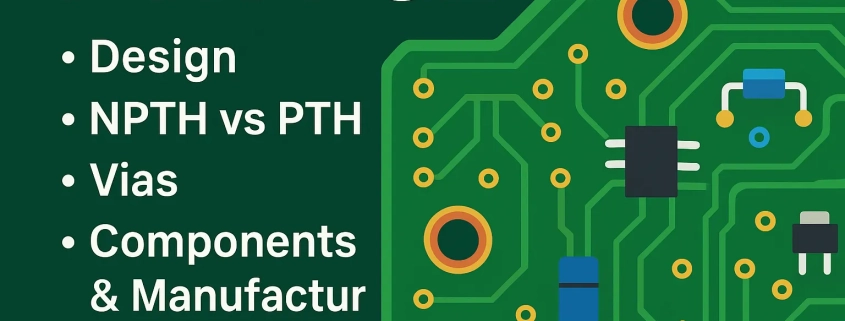PTH PCB Guide: Design, NPTH vs PTH, Vias & Components
Plated Through Hole (PTH) PCB technology ensures reliable electrical connections and mechanical strength in circuit boards. Unlike NPTH, PTH holes are copper-plated to connect layers and support components. Designers must optimize hole size, annular ring, and thermal performance while distinguishing PTH from vias, which primarily handle interlayer routing—from PTH resistors and connectors to the complete PCB manufacturing process.
What is PTH in PCB?
Plated Through Hole (PTH) refers to holes drilled through a PCB that are plated with copper, enabling electrical connections between layers. It is the foundation of through-hole technology (THT), where component leads are inserted and soldered, ensuring strong mechanical and electrical bonds. PTH is crucial for high-reliability electronics where durability matters.
Get a Quotation For FPTH PCB Now
PTH Type of PCB
PTH technology can be implemented in single-sided, double-sided, and multilayer PCBs. Compared to SMT (Surface Mount Technology), PTH provides superior strength, making it ideal for:
- Power supply boards
- Automotive electronics
- Aerospace and military PCBs
- Industrial control systems
These applications require robust PTH PCBs that can handle higher currents and mechanical stress.
Get a Quotation For FPTH PCB Now
PTH PCB Design Considerations
When designing a PTH PCB, engineers should consider:
- Hole size & annular ring width: Ensures manufacturability and solder reliability.
- Clearance & spacing: Prevents short circuits.
- PTH vs Via: Vias are for signal routing, PTH holes are for component mounting.
- Thermal & current capacity: Important for power and high-frequency circuits.
Good PTH PCB design balances electrical performance and mechanical stability.
Get a Quotation For FPTH PCB Now
PTH and NPTH in PCB
- PTH (Plated Through Hole): Conductive, used for electronic components.
- NPTH (Non-Plated Through Hole): Non-conductive, used for mounting or alignment.
In PTH and non-PTH double-sided PCBs, both hole types coexist:
- PTH for interconnection and soldering
- NPTH for screws, tooling holes, and mechanical functions
PTH Components List
Common PTH components include:
- Resistors, capacitors, diodes, transistors
- Connectors, pin headers, relays
- Transformers, inductors, power semiconductors
These parts are chosen for durability, reliability, and power-handling capability.
Get a Quotation For FPTH PCB Now
How to Make PTH PCB?
The PTH PCB manufacturing process consists of:
- Drilling – precise hole creation
- Desmearing – cleaning hole walls
- Chemical Copper Deposition – forming a thin conductive layer
- Electroplating – strengthening copper walls
- Imaging & Etching – defining circuit patterns
- Surface Finishing & Solder Mask – finalizing protection and solderability
Key challenges include plating uniformity, adhesion reliability, and hole wall quality.
NPTH vs PTH – Key Differences
- Conductivity: PTH conducts electricity, NPTH does not
- Manufacturing: PTH requires plating, NPTH is drilled only
- Applications: PTH for electronics, NPTH for mechanics
NPTH vs PTH comparison is crucial for selecting the right hole type in PCB design.
Get a Quotation For FPTH PCB Now
PTH vs Via
While both are copper-plated holes, they serve different purposes:
- PTH: Larger, designed for component insertion and conduction
- Via: Smaller, only for interlayer signal routing
Understanding PTH vs via ensures optimal PCB layout.
Get a Quotation For FPTH PCB Now
PTH PCB Manufacturing & Service Providers
Top PTH PCB manufacturers include:
- JLCPCB – cost-effective prototyping & mass production
- Eurocircuits – European quality PCB manufacturing
- RushPCB – high-reliability PTH solutions
- iPCB – advanced multilayer PTH PCB services
When choosing a provider, check minimum hole size, plating quality, and layer support.
Get a Quotation For FPTH PCB Now
Advantages and Challenges of PTH Technology
Advantages of PTH PCB:
- Stronger mechanical support
- High current handling capability
- Reliability in harsh conditions
Challenges of PTH PCB:
- Higher cost than SMT
- More PCB space required
- Slower assembly speed



